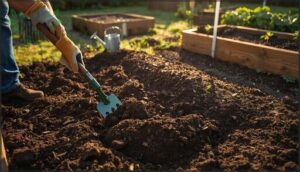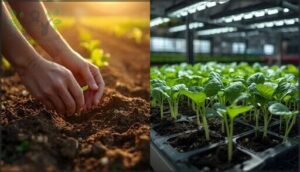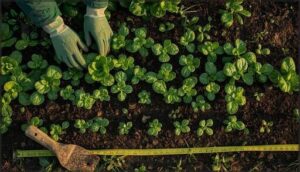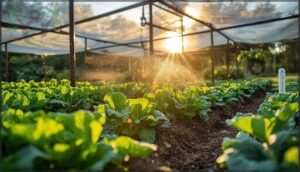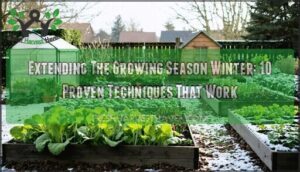This site is supported by our readers. We may earn a commission, at no cost to you, if you purchase through links.
Most gardeners think of summer as the time to harvest cool season crops, not plant them. But here’s what experience teaches: a well-timed summer sowing can deliver fresh broccoli, kale, and carrots right through fall and into winter.
The trick lies in working backward from your first frost date and choosing varieties bred to handle the heat stress of germination before cooler weather arrives. This approach transforms your garden from a single-season operation into a continuous production system.
Summer planting capitalizes on declining temperatures and autumn moisture patterns that cool season vegetables prefer. You’ll bypass the spring rush, reduce competition for garden space, and fill the gap between your last tomato and first frost with nutrient-dense greens and roots that actually improve in flavor after a light freeze.
Table Of Contents
Key Takeaways
- Planting cool season crops in late summer extends your harvest into fall and winter by working backward from your first frost date and selecting heat-tolerant, bolt-resistant varieties that can germinate in warm soil before cooler weather arrives.
- Summer planting delivers multiple benefits, including better water efficiency through lower evaporation rates, improved soil health from continuous ground cover, and economic advantages from producing crops during off-peak market periods when competition is reduced.
- Success depends on managing heat stress through shade cloth that reduces temperatures by 10-20°F, mulch that lowers soil temperature by 5-7°F and retains 20-25% more moisture, and consistent irrigation of 1-2 inches per week depending on your climate.
- Calculate your planting schedule by adding a “fall factor” of 10-14 days to seed packet maturity times plus another 7-14 days for harvest window, then count backward from your first frost date to determine when seeds should go in the ground.
Why Plant Cool Season Crops in Summer?
Planting cool season crops in summer might sound backward, but it’s actually a smart move for any gardener looking to increase their harvest.
This approach opens up benefits you mightn’t expect. Here’s why summer planting deserves a spot in your garden plan.
Benefits of Summer Planting
When you plant cool season crops in late summer, you’re setting yourself up for success on multiple fronts. Crop diversification breaks pest cycles and keeps your garden productive. Here’s what summer planting delivers:
- Water efficiency through lower evapotranspiration rates
- Soil improvement from continuous ground cover
- Economic advantages via extended availability in niche markets
- Enhanced biodiversity across your growing space
- Reduced competition during off-peak harvest periods
Cool weather gardening in summer isn’t counterintuitive—it’s strategic. Understanding cool weather crops can help you make informed decisions about your garden.
Extending The Harvest Season
Extending your harvest season starts with smart timing. When you plant cool-season crops in late summer, frost tolerance works in your favor—kale, carrots, and leeks actually improve after light freezes.
Succession planting every two to three weeks keeps greens coming. Brassicas, for example, need 70-80 days to mature for fall harvest.
Combine microclimate control through row covers with thoughtful variety selection. Proper storage methods let you enjoy cool weather gardening rewards well into winter.
Economic and Sustainability Advantages
Beyond season extension techniques, summer-planted cool-season crops deliver real financial returns. Your planting schedule becomes a profit strategy when you embrace crop rotation.
Here’s what the numbers show:
- Fall broccoli rotations yield over $3,000 per acre net returns
- Cover crops reduce fertilizer needs by up to 30 pounds per acre
- Succession planting cuts annual income variability
- Soil health improves 15-20% after three-year rotations
- Resource efficiency gains lower irrigation costs markedly
Farm profitability, market stability, and sustainability outcomes all improve together.
Choosing The Right Cool Season Vegetables
Not every cool season vegetable reacts to summer planting the same way. Some thrive with a little extra care, while others need bolt-resistant varieties to survive the heat.
Here’s a look at your best options by category.
Brassicas (Broccoli, Kale)
Brassicas like broccoli and kale are workhorses of summer gardening when you’re planning a fall harvest. These cool-season vegetables thrive when transplanted between late July and mid-August. Heat-tolerant varieties such as ‘Imperial’ and ‘Monty’ broccoli resist bolting and maintain quality during warm spells.
| Crop | Transplant Window | Days to Maturity |
|---|---|---|
| Broccoli | Late July–Mid August | 80 or fewer |
| Kale | Late July–Mid August | 55–75 |
| Cabbage | Late July–August | 70–100 |
For yield optimization, keep plants well-watered and use insect netting for pest management. Bolting prevention depends on consistent moisture and avoiding cold snaps once plants develop 5–8 true leaves.
Root Vegetables (Carrots, Radishes)
Root vegetables like carrots and radishes make excellent cool-season vegetables for late summer sowing. Heat-tolerant cultivars such as ‘Atlas’ carrots and ‘Sora’ radishes handle warm soil better than standard types.
Here’s what matters for summer success:
- Choose heat-adapted varieties to reduce summer bitterness
- Maintain consistent moisture to prevent soil penetration issues
- Practice succession sowing every 10–14 days
- Use row covers to lower pest incidence
Leafy Greens (Lettuce, Spinach)
Leafy greens like lettuce and spinach thrive as cool-season vegetables when you plant heat-tolerant varieties in late summer. Bolting prevention starts with timing—aim for mid-August through mid-September sowings.
Your success depends on shade management using 30-50% shade cloth, consistent summer irrigation, and succession planting every two weeks. These strategies keep leaves tender and harvests coming well into fall.
Alliums (Scallions, Onions)
Among cool-season vegetables, alliums like scallions and onions offer surprising summer potential. Selected summer cultivars can handle daytime temperatures above 30°C while maintaining quality.
Your sowing practices matter—space scallions 2–3 inches apart for better airflow. Soil requirements include medium moisture and pH between 5.5–6.5.
Don’t overlook pest management either. Removing old allium residue before late summer planting cuts pest problems by 40%. Watering needs stay moderate with these vegetable varieties.
Bolt-Resistant and Heat-Tolerant Varieties
What if your lettuce could laugh off a 90°F day? That’s the promise of bolt-resistant varieties and heat-tolerant varieties bred for summer performance. Batavian-type lettuce, for example, showed zero bolting across 26 days above 90°F.
Bolt-resistant lettuce varieties can endure 90°F heat without flowering, proving that smart breeding beats summer stress
Hybrid vigor in cultivars like ‘Vivian’ romaine delivers climate resilience you can count on. Your variety selection of cool-season crops determines whether summer heat wins or you do.
Planning Your Planting Schedule
Timing is everything when you’re planting cool season crops in summer. You’ll need to work backwards from fall’s first frost to figure out exactly when to get seeds in the ground.
Here’s how to map out your planting schedule for a successful harvest.
Knowing Your First Frost Date
Your first frost date is the anchor of your entire planting schedule. Without it, you’re guessing—and guessing rarely ends well for cool-season crops.
Frost date averages vary dramatically across regions. Consider these regional frost variations:
- Maine sees first frost between September 1 and October 20
- Alabama ranges from October 11 to November 30
- Illinois spans September 21 to November 10
- Climate change impact has delayed first frost by 11 days in 85% of U.S. cities
Understanding frost probability risks helps you time vegetable varieties precisely. Check your local extension office or search by ZIP code for location-specific data. This frost date consideration directly shapes your planting times and protects your investment.
Calculating Days to Maturity
Days to maturity aren’t fixed numbers—they flex with temperature, soil conditions, and planting times. Seed packets list baseline estimates, but you need to account for environmental impact and slower fall growth.
Start by adding a “fall factor” of 10–14 days for summer-planted cool-season crops. Then extend harvest windows by another 7–14 days if you’re picking after the first frost.
| Vegetable Varieties | Spring Maturity | Summer-to-Fall Maturity |
|---|---|---|
| Broccoli | 50–60 days | 55–70 days |
| Carrots | 60–70 days | 70–80 days |
| Lettuce | 45–55 days | 55–70 days |
| Spinach | 40–50 days | 50–60 days |
Crop maturity shifts when planting times change. Late plantings compress vegetative growth but may extend reproductive phases if heat persists. Growing Degree Days (GDD) calculations—using daily temperature averages minus a base temperature of 5–10°C—help predict actual germination and maturity more accurately than calendar dates alone.
For precise planning, use this formula: listed days to maturity + harvest period (7–14 days) + fall factor (10–14 days). Planting shifts can reduce development time by 5–20%, but unpredictable summer temperatures may throw off predictions by two weeks.
Succession Sowing Strategies
Once you know your maturity windows, succession planting strategies keep your harvest rolling. Sowing intervals of 10–14 days work well for lettuce and spinach, while faster-growing radishes can be planted every 7 days. This approach maximizes yield and extends your season by 6–10 weeks.
Here’s how to build your succession plan:
- Stagger planting times every 1–2 weeks for continuous germination and harvest flow.
- Mix early and late varieties to create overlapping harvests without gaps.
- Adjust intervals for summer heat—shorten by 25% in mid-summer when cool-season crops grow faster.
Crop diversity matters too. Rotating between different vegetable families reduces pest pressure and improves soil health. Environmental adaptation is key: use shade cloth and mulch to maintain ideal soil temperatures between 10–26°C for best germination.
Preparing Soil and Garden Beds
Your soil is the foundation for a successful fall harvest. Cool-season crops need specific temperature and fertility conditions to thrive when planted during summer heat.
Let’s look at three key steps to prepare your garden beds for strong growth and better yields.
Soil Temperature and Moisture Needs
Before you sow seeds, check soil temperature with a probe. Best germination for cool-season crops happens between 40°F and 65°F, so summer management means keeping things cool. Elevated temperatures above 75°F stress seedlings and hurt moisture retention.
You’ll need consistent watering techniques during seedling establishment—aim for soil moisture above 50%. Use mulch and shade to moderate surface heat, making your soil preparation work harder for you.
Adding Organic Matter and Fertility
Once your soil hits the right temperature, you’ll want to enrich it for cool-season crops. Work organic matter into the top 6 to 8 inches before planting. This soil amendment boosts biological activity and water retention while cutting fertilizing costs.
Here’s your soil preparation game plan:
- Apply 2 to 3 inches of compost at standard application rates
- Mix in aged manure for steady nutrient release
- Incorporate cover crop residue to increase soil organic matter
- Top-dress mid-season for economic benefits and continued fertility
Raised Beds and No-Till Methods
Raised beds offer striking advantages for cool-season crops. Soil warming happens 1 to 3 weeks earlier in spring, while yields jump 20 to 25% per square foot through intensive planting.
No-till methods boost these benefits further—weed suppression reaches 66 to 80% with tarping, water retention increases by 25% during drought, and pest management improves as beneficial organisms thrive in undisturbed soil.
Sowing and Transplanting Techniques
Getting your seeds or seedlings into the ground at the right time makes all the difference when planting cool season crops in summer. You have two main approaches: direct sowing seeds straight into the soil or starting them indoors first and transplanting later.
Each method has its place depending on which vegetables you’re growing and how much heat stress you need to avoid.
Direct Sowing Vs. Indoor Starting
Choosing between direct seeding and seed starting indoors comes down to a cost-benefit analysis. Cool-season crops like brassicas benefit from environmental control indoors, with seedling survival rates reaching 85-95% versus 70-85% outdoors.
Direct sowing reduces labor requirements but risks transplant shock in root vegetables.
Indoor seed starting methods offer reliability despite higher initial costs, especially when summer weather turns unpredictable.
Transplanting Seedlings in Summer
When transplanting seedlings during summer heat, timing makes all the difference. Move transplants in late afternoon or evening to reduce heat stress and boost survival rates. Acclimation over 7-10 days strengthens resilience, while watering before and after transplanting cuts mortality by 30%.
Keep soil temperature between 60-65°F using shade cloth and mulch. Summer gardening practices demand attention to seedling development under challenging conditions.
Spacing and Thinning Practices
After transplanting seedlings, proper spacing and thinning timing help achieve ideal density for healthy growth. Thin leafy greens when the second true leaf appears to prevent stunting. Root crops benefit from staged thinning to 1–2 inches apart, boosting yield quality without damaging neighbors.
In intensive beds, plan garden planning around square-foot densities. Summer resowing under challenging growing conditions demands consistent spacing adjustments as planting progresses.
Managing Heat Stress and Growth Challenges
Summer heat presents the biggest obstacle when you’re growing cool season crops outside their normal window. Your plants need protection from high temperatures that can stunt growth or trigger early flowering.
The following strategies will help you create the right conditions for strong development through the warmest months.
Using Shade Cloth and Mulch
Heat stress can turn promising cool-season crops into disappointments, but shade cloth and mulch offer practical solutions. These tools work together to create a cooler microenvironment that fosters healthy growth during summer planting.
Key Benefits of Shade Cloth and Mulch:
- Temperature Reduction – Shade cloth lowers ambient temperatures by 10–20°F, while mulch reduces soil temperature by 5–7°F
- Moisture Retention – Mulched beds retain 20–25% more moisture and reduce evaporation
- Yield Improvement – Protected crops produce more marketable fruits with better quality
- Pest Prevention – Mulch creates a barrier against fruit rot and reduces weed pressure by 50–70%
- Resource Efficiency – Combined use cuts irrigation cycles by up to 40%
Use 30–50% shade cloth to prevent leaf burn and sunscald without blocking necessary light. Apply organic mulch around plants to insulate roots and maintain consistent soil conditions throughout hot periods.
Irrigation and Moisture Control
Watering frequency makes or breaks summer-planted cool-season crops. You need 1 to 1.5 inches per week in moderate climates, increasing to 2 inches in arid regions for best germination and growth.
Drip efficiency cuts water use by 60% compared to sprinklers while managing heat stress. Mulching benefits include 20–25% better soil retention, providing consistent moisture that aids heat mitigation and proper soil preparation throughout summer’s challenges.
Preventing Bolting and Pests
Vegetable bolting issues and managing garden pests threaten summer-planted cool-season crops, but proven strategies protect your harvest.
Proven Strategies:
- Shade cloth (30-50%) cuts soil temperature by 10°F and delays bolting up to 14 days in leafy greens
- Mulching practices lower soil temperature 4-8°F while reducing premature bolting by 20%
- Variety selection of bolt-resistant cultivars combined with physical barriers decreases pest incidence by 70%
Soil health supports all pest control efforts.
Frequently Asked Questions (FAQs)
Which crops handle humidity better in summer planting?
Brassicas like cabbage, kale, and collards handle high humidity remarkably well when you manage foliar diseases with fungicides.
Root vegetables such as carrots and heat-tolerant radish varieties also thrive under moist summer conditions with consistent watering.
How do you protect seedlings from intense sun?
You protect seedlings from intense sun by deploying 40% shade cloth when temperatures reach 85°F, applying mulch to moderate soil temperature, or using floating covers to create cooler microclimates around vulnerable transplant seedlings.
When should you start hardening off summer seedlings?
Think of hardening off as building calluses—slow and steady wins. Start the process 7–14 days before transplanting, when seedlings are at least 4–6 weeks old and nighttime temperatures stay above freezing.
Conclusion
Picture a November garden still producing tender kale and sweet carrots while neighbors’ plots sit bare. That’s the payoff of planting cool season crops in summer.
You’ve learned the timing calculations, soil preparation methods, and heat management strategies that make fall harvests possible. Now take your first frost date, count backward from maturity requirements, and get those seeds in the ground. Your winter table will thank you for the foresight.
- https://extension.sdstate.edu/season-extension-fall-specialty-crops
- https://extension.psu.edu/cool-season-vs-warm-season-vegetables/
- https://rootsandrefuge.com/what-to-plant-in-july/
- https://extension.umd.edu/resource/vegetable-planting-calendar
- https://www.azurefarmlife.com/farm-blog/best-summer-season-vegetables-that-love-heat




